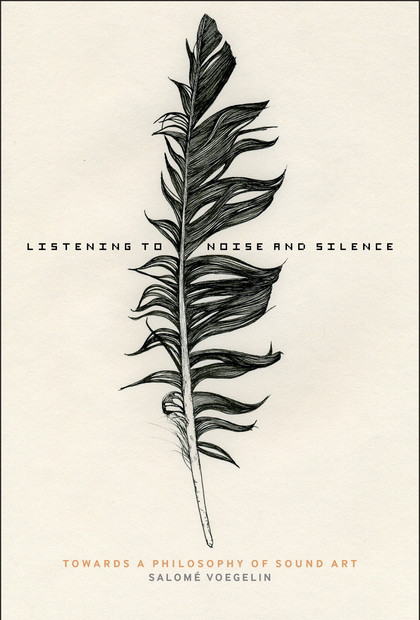Jonathan Sterne: MP3: The Meaning of a Format (2012)
Filed under book | Tags: · codec, compression, filesharing, history of technology, information theory, listening, mp3, noise, piracy, psychoacoustics, recording, silence, sound recording, technology

“MP3: The Meaning of a Format recounts the hundred-year history of the world’s most common format for recorded audio. Understanding the historical meaning of the MP3 format entails rethinking the place of digital technologies in the larger universe of twentieth-century communication history, from hearing research conducted by the telephone industry in the 1910s, through the mid-century development of perceptual coding (the technology underlying the MP3), to the format’s promiscuous social life since the mid 1990s.
MP3s are products of compression, a process that removes sounds unlikely to be heard from recordings. Although media history is often characterized as a progression toward greater definition, fidelity, and truthfulness, MP3: The Meaning of a Format illuminates the crucial role of compression in the development of modern media and sound culture. Taking the history of compression as his point of departure, Jonathan Sterne investigates the relationships among sound, silence, sense, and noise; the commodity status of recorded sound and the economic role of piracy; and the importance of standards in the governance of our emerging media culture. He demonstrates that formats, standards, and infrastructures—and the need for content to fit inside them—are every bit as central to communication as the boxes we call “media.””
Publisher Duke University Press, Durham, NC, September 2012
Sign, Storage, Transmission series
ISBN 0822352877, 9780822352877
341 pages
Reviews: Robert Barry (review31), Hillegonda Rietveld (Times Higher Education), Hua Hsu (Slate).
Interview with the author: Eric Harvey (Pitchfork).
PDF (updated on 2021-4-9)
Comment (0)Salomé Voegelin: Listening to Noise and Silence: Towards a Philosophy of Sound Art (2010)
Filed under book | Tags: · aesthetics, noise, philosophy, silence, sound art, sound recording

“Listening to Noise and Silence engages with the emerging practice of sound art and the concurrent development of a discourse and theory of sound. In this original and challenging work, Salomé Voegelin immerses the reader in concepts of listening to sound artwork and the everyday acoustic environment, establishing an aesthetics and philosophy of sound and promoting the notion of a sonic sensibility.
A multitude of sound works are discussed, by lesser known contemporary artists and composers (for example Curgenven, Gasson and Federer), historical figures in the field (Artaud, Feldman and Cage), and that of contemporary canonic artists such as Janet Cardiff, Bill Fontana, Bernard Parmegiani, and Merzbow.
Informed by the ideas of Adorno, Merleau-Ponty and others, the book aims to come to a critique of sound art from its soundings rather than in relation to abstracted themes and pre-existing categories. Listening to Noise and Silence broadens the discussion surrounding sound art and opens up the field for others to follow.”
Publisher Continuum, London and New York, 2010
Music/Sound Studies series
ISBN 1441162070, 9781441162076
256 pages
Reviews: Daniela Cascella (Journal of Sonic Studies), Brian Kane (NonSite).
PDF (updated on 2018-4-30)
Comment (1)Caleb Kelly (ed.): Sound (2011)
Filed under book | Tags: · acoustics, art, art criticism, art history, contemporary art, listening, music, music theory, noise, silence, sound art, sound recording

“Sound is one of a series documenting major themes and ideas in contemporary art.
The ‘sonic turn’ in recent art reflects a wider cultural awareness that sight no longer dominates our perception or understanding of contemporary reality. The background buzz of myriad mechanically reproduced sounds increasingly mediates our lives. Tuning in to this incessant auditory stimulus some of our most influential artists have investigated the corporeal, cultural and political resonance.
In tandem with recent experimental music and technology, art has opened up to hitherto excluded dimensions of noise, silence and the act of listening. Artists working with sound have engaged in new forms of aesthetic encounter with the city and nature, the everyday and cultural otherness, technological effects and psychological states.
New perspectives on sound have generated a wave of scholarship in musicology, cultural studies and the social sciences. But the equally important rise of sound in the arts since 1960 has so far been sparsely documented. This volume is the first sourcebook to provide, through original critical writings and artists’ statements, a genealogy of sonic pathways into the arts; philosophical reflections on the meanings of noise and silence; dialogues between art and music; investigations of the role of listening and acoustic space; and a comprehensive survey of sound works by international artists from the avant-garde era to the present.”
Artists surveyed include Marina Abramović, Vito Acconci, Doug Aitken, Maryanne Amacher, Laurie Anderson, John Cage, Kim Cascone, Martin Creed, Paul DeMarinis, Bill Fontana, Kim Gordon, Dan Graham, Ryoji Ikeda, Mike Kelley, Christina Kubisch, Bernhard Leitner, Alvin Lucier, Len Lye, Christian Marclay, Max Neuhaus, Carsten Nicolai, Hermann Nitsch, Yoko Ono, Nam June Paik, Luigi Russolo, Karin Sander, Mieko Shiomi, Michael Snow and Bill Viola.
Writers include Ralph T. Coe, Christoph Cox, Suzanne Delehanty, William Furlong, Liam Gillick, Paul Hegarty, Branden W. Joseph, Douglas Kahn, Dan Lander, W.J.T. Mitchell, Michael Nyman, R. Murray Schafer, Michel Serres, David Toop and Paul Virilio.
Publisher Whitechapel Gallery, London, with MIT Press, Cambridge, MA, 2011
Documents of Contemporary Art series
ISBN 0854881875, 9780854881871
239 pages
review (Neural)
review (Sophie Hoyle, an)
PDF (biographies on pp 224-227 are missing)
Comments (3)
